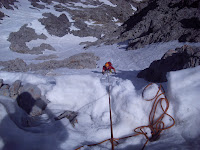We spent more than a month this spring trying to get on the face between bouts of bad weather and high avalanche danger. The weather finally gave us a window and we were able to climb the route on Friday July 2, 2010.
Both Kyle and I were a bit nervous as we approached the base of the route and gazed up at the steepness of the angle and the ominous overhanging cornice that guarded the exit onto the summit ridge. However, we found the snow, ice and rock to be solid, and Kyle even placed an ice piton in over 12 inches of hard alpine ice when building a belay anchor near the top of the couloir.
This route is easily accessed (we drove up Long Canyon in Kyles Subaru) and has one of the most beautiful and easy approaches I've ever done in the Central Idaho ranges.
I HIGHLY recommend this route to anyone who wants a moderate mountaineering objective with UNBEATABLE alpine views. It would serve as a good warm-up to the classic White Line Couloir (WI4, M5) on Peak 11308 in the Lost River Range.
Here is a brief route description and some photos that I hope get some guys excited to climb the route for themselves.
 Miskin-Steadman Route
Miskin-Steadman RouteSnow, AI 3; 1800 feet
Sheep Mountain North Face
Lemhi Range, Idaho
FA: July 2, 2010; Garon Miskin and Kyle Steadman
This beautiful route climbs the continuous couloir fourth from the left when looking at the north face of Sheep Mountain. The short, easy approach, remoteness and moderate nature of this route makes it a ‘must do’ for every Idaho mountaineer.
 Approach via Long Canyon from the Gilmore main road. The road up Long Canyon forks about mid-way. The LEFT fork is identified by a Forest Service sign indicating FS Road 1A, continue along the RIGHT for another 0.75 miles. When the road dips downward, locate a small pullout to the left and park. Hike directly west and drop quickly into a small drainage. More or less follow the drainage (when in doubt stay low and left) for approximately 1.5 miles on easy ground to a large meadow. The North Face of Sheep Mountain will be in full view. Cross the meadow to another smaller meadow and cross to the edge of the meadow, into the trees and emerge out of tree-line at the base of the route.
Approach via Long Canyon from the Gilmore main road. The road up Long Canyon forks about mid-way. The LEFT fork is identified by a Forest Service sign indicating FS Road 1A, continue along the RIGHT for another 0.75 miles. When the road dips downward, locate a small pullout to the left and park. Hike directly west and drop quickly into a small drainage. More or less follow the drainage (when in doubt stay low and left) for approximately 1.5 miles on easy ground to a large meadow. The North Face of Sheep Mountain will be in full view. Cross the meadow to another smaller meadow and cross to the edge of the meadow, into the trees and emerge out of tree-line at the base of the route.  The route begins directly out of tree-line and narrows very quickly. The lower one-third is 40-50 degree hard snow. After a few easy pitches, the couloir steepens to 60 degrees and becomes narrower. In the upper half the climbing becomes more varied and more difficult. The angle approaches 70 degrees and continually steepens with the final two pitches of 80 degree alpine ice and an exhilarating exit consisting of 30 feet of vertical alpine ice leading to the summit ridge. The route was protected with running belays in the lower sections and belay stances in the upper couloir were easily found and well protected.
The route begins directly out of tree-line and narrows very quickly. The lower one-third is 40-50 degree hard snow. After a few easy pitches, the couloir steepens to 60 degrees and becomes narrower. In the upper half the climbing becomes more varied and more difficult. The angle approaches 70 degrees and continually steepens with the final two pitches of 80 degree alpine ice and an exhilarating exit consisting of 30 feet of vertical alpine ice leading to the summit ridge. The route was protected with running belays in the lower sections and belay stances in the upper couloir were easily found and well protected. Gear: 4 snow stakes, 4-5 lost arrows & knifeblades, 2 ice screws (18 cm), 4-5 small cams up to a #2 Camalot. The rock is solid and objective hazard is low, except for the overhanging cornice which extends along the entire rim of the upper bowl. Check avalanche conditions prior to ascending.
Descent: Descend the SW Ridge and locate the last couloir which appears to descend straight down to the base of the route. You know it’s the right one because the top is the most moderate angle from off the SW Ridge. At the point where the descent couloir appears to cliff out, traverse right (south), connecting narrow ledges until more moderate downclimbing is revealed. Alternately, descend all the way right into the lower section of the next couloir and downclimb steep, soft snow.









